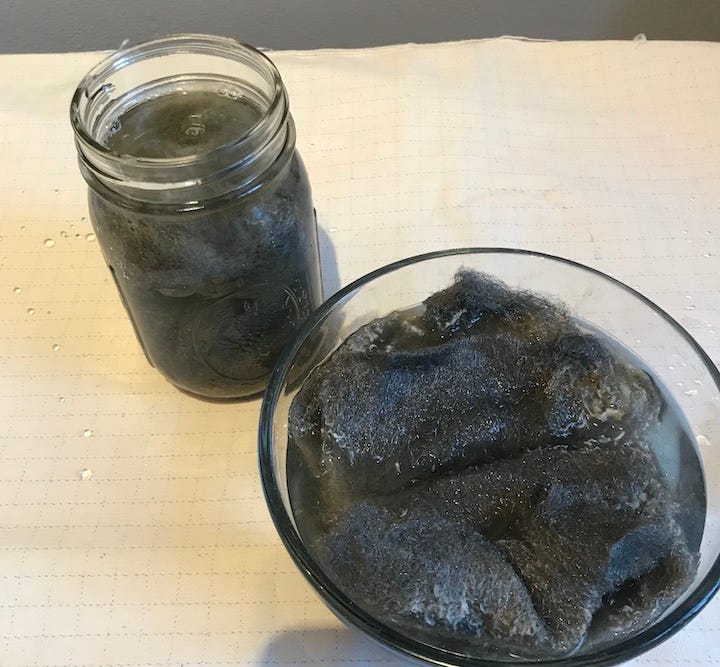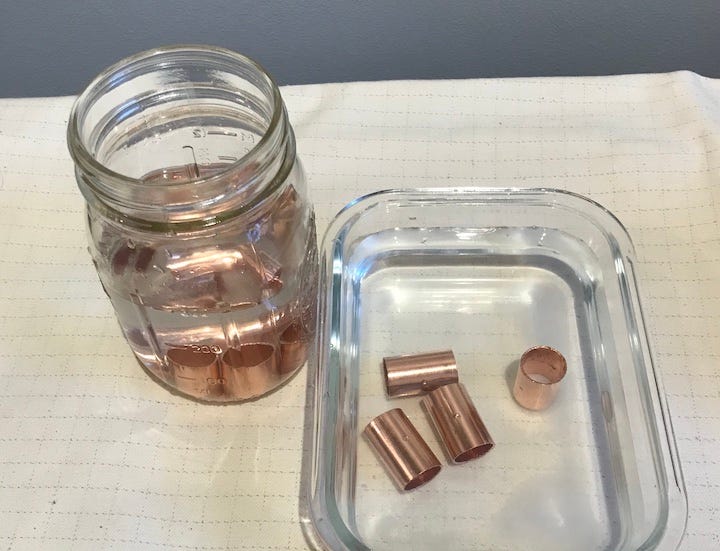Art Adventre • 09.06.2023 • Red Iron Oxide and Verdigris
I’m still looking for an efficient way to pulverize rocks, so in the meantime I decided to experiment with some pigments that can be created through chemical reactions. The two I chose to start with, because the colors are exceptionally beautiful and the components easily obtained, were red iron oxide and verdigris.
Red iron oxide is simply rust. Gamblin makes a transparent red iron oxide that is not only spectacular in itself, but it mixes with ultramarine blue and white to make an infinite range of warm grays that are standard colors on my palette.
Verdigris is the blue-green crystal that you see on roofs with copper flashing, weather vanes, and your pipes when they begin to corrode. I have never used verdigris, though I have no idea why not. Verdigris oil paint, which Vermeer and other Old Masters used as a glaze, is available from several manufacturers.
Both pigments result from oxidation—of iron, obviously, in the case of red iron oxide (it is oxidized iron in rock that creates red ochre), and of copper in the case of verdigris.

The supplies for making red iron oxide are old rusty things found on the street, or steel wool, and hydrogen peroxide; for verdigris, cleaning vinegar and copper, such as plumbing doodads available at the hardware store, are required.
NB: Verdigris is apparently highly toxic. Take recommended precautions if you decide to try this.

Which leads to a conundrum: Are the pigments I am making really sourced from natural materials found in New England if I found the materials at the hardware store or the grocery store ?
I didn’t have any qualms in regard to the blue mussels—they were sourced from the Gulf of Maine even if I was not the one to dig them up.
I extrapolated from that principle in regard to iron and copper. Iron and copper mines were present in New England at one time. The first colonial iron works was established in the South Shore of Boston to process bog iron in the mid-seventeenth century.
My longtime friend Nick Humez, always a fount of the most extraordinary information, told me a couple of months ago, “[The Saugus Iron Works] was founded in the 1640s to manufacture iron by raking up and smelting the nodules formed by the Leptothrix bacteria as a precipitate on swamp bottoms and thus, it was hoped, as a local source of iron for the Mass. Bay colonies, in preference to iron brought to New England as ballast on ships from Britain. Gabbro, for flux, was available from Nahant, close by, and ample supplies of timber that could be baked into charcoal for the smelting furnaces. The enterprise started promisingly but was not well managed and burned through the available timber for charcoal, so the original foundry, after going belly up, was rebuilt further upstream. (That enterprise failed too. Eventually it was bought and turned into snuff factory, the biggest in the colonies at that time.)”
The mines began to disappear when they became too inefficient to operate profitably and other, more productive sources of the ores were found. But surely the iron and copper are still here, even if they are no longer commercially exploited.
So I am, for the moment at least, considering that purchased iron and copper meet my criterion of local materials even though I did not go out and find them, and despite the fact that what I bought most likely did not come from New England. The other reason for including these materials is that I am hoping to document sources of pigment that would be available to other artists, who probably don’t know how to smelt iron or copper either. It’s a bit of a stretch, I know, but I can live with it.
An aside: There is a copper mine in Topsfield, Mass., for which Gleba gives coordinates, and I am eager to see if I can find it and discover if the blue-green color is visible anywhere. Further, I am beginning to think that maybe the stain on the rocks we found at the old Hopkinson Springs could be verdigris. I’ll have to find out how you test for copper.
Vinegar is simply acetic acid, which is formed by fermentation of rotting fruits and vegetables. Traces have been discovered in Egyptian urns made 5000 years ago. Surely it was and is easily sourced in New England.
Hydrogen peroxide (H2O2) is not a naturally-occurring substance. It was discovered in 1818 by Louis Jacques Thénard and used as a disinfectant. Researchers are looking for ways to manufacture it locally in remote communities because it so effective in purifying water. Hydrogen peroxide is essentially water with an extra oxygen atom, which is loosely bound to the molecule. H2O2 is therefore highly reactive and a powerful oxidizing agent.
So much for locally-sourced natural materials.
But I have devised a loop hole. The same reaction to make rust from iron occurs if you use water instead of hydrogen peroxide. It just takes a lot longer.
I am not a patient person, so I am willing to allow hydrogen peroxide for this project rather than wait months for water to do its work.